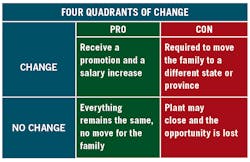How to overcome your workers’ natural resistance to change
At the recent Society for Maintenance and Reliability Professionals (SMRP) conference, I had the opportunity to lead a workshop on change management. In this month’s column, I wanted to share some of the highlights of the workshop to help you with leading change in your organization.
While there are many change models, I frequently reference John Kotter’s approach, which can be found in his book, Leading Change.
With Kotter’s model, there are eight points to the process.
For creating urgency and developing the change vision, Simon Sinek in his TED Talk, Start with Why provides details of what differentiates inspiring leaders and organizations. He shares that “all the great inspiring leaders and organizations in the world, they all think, act, and communicate the exact same way. And it's the complete opposite to everyone else.”
In his work, Sinek came upon a discovery that he calls the Golden Circle, a series of three nested circles, each progressively larger. The inner circle contains the “Why?”, the slightly larger circle contains the “How?”, and the last circle contains the “What?”. Recognize 100% of the people within an organization know what they do, less understand how they do it, and very few get the purpose, the why. You might think the why is to generate a profit, but Sinek notes that is a result. The why is the purpose, the belief, or the cause.
With his discovery, he found that most organizations go from the outside in with the circles, from What to How to Why. Conversely, the organizations and leaders that inspire people to believe begin with the purpose, from the inside out, from Why to How to What. Get people to believe in the need for change by focusing on the Why.
Getting the first followers to join in believing means that we need to help them overcome their fears and establish trust. To illustrate this concept, refer to the matrix graphic that follows. Typically, leaders talk about the benefits of making the change from their perspective. In the upper left quadrant, a person may be encouraged to take a promotion that will yield a higher salary. Yet, status and money will not encourage everyone to make the change. We must answer the “What’s in it for me?" (WIIFM) question by addressing all four quadrants.
In the workshop, we leveraged a one-hour exercise to help the attendees understand some of the reasons that people resist change. The attendees were divided into employee and manager groups. Employees were randomly seated in rows of chairs. The management group attempted to create a compelling reason for the change and cast their vision of the future state. Then, each employee was asked to align to the new structure by moving to a sequentially numbered chair. While the employees would have been compensated to move chairs, about one-half of the employees chose not to move. They voiced fears of the unknown and apprehension with the way the management group approached the change. A lack of trust was a factor. The exercise was quite telling and surprised the workshop attendees.
Interestingly, Heraclitus, around 500 B.C., was quoted as saying, “Change is the only constant.” Yet, 70% of all change implementations fail, often due to errors in implementing change. No doubt, people resist change they don’t understand or believe in. In addition to providing an inspiring vision, change leaders must become marketers. Studies show that the typical employee receives more than 2 million words across a three-month period. The typical communication regarding the change vision across that same period is less than 20,000 words. Doing the math, less than 1% of the communication is dedicated to inspiring change. Kotter notes that we under-communicate by a factor of 10 times or more. Constantly reinforce communication in all forms. The messaging includes talks, articles, newsletters, presentations, storyboards, and so on.
Focus on creating small wins that compound to build bigger wins. Start with the first followers that are inspired. Use the wins to create momentum, which becomes the tipping point. Empower people for broad-based change. Use metrics. Every point in a process can provide the ability to leverage metrics that drive behaviors with the goal of changing the culture.
This story originally appeared in the November/December 2022 issue of Plant Services. Subscribe to Plant Services here.
From the Plant Floor
From the Plant Floor is a new monthly column that explores reliability challenges faced by organizations and solutions to overcome them.
About the Author
Jeff Shiver
Founder and managing principal at People and Processes, Inc.
Jeff Shiver CMRP is a founder and managing principal at People and Processes, Inc. Jeff guides people to achieve success in maintenance and reliability practices using common sense approaches. Visit his website www.PeopleandProcesses.com, and contact him on LinkedIn at www.linkedin.com/in/jeffshiver or via email at [email protected].



